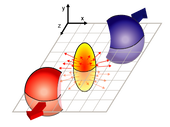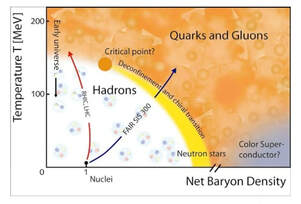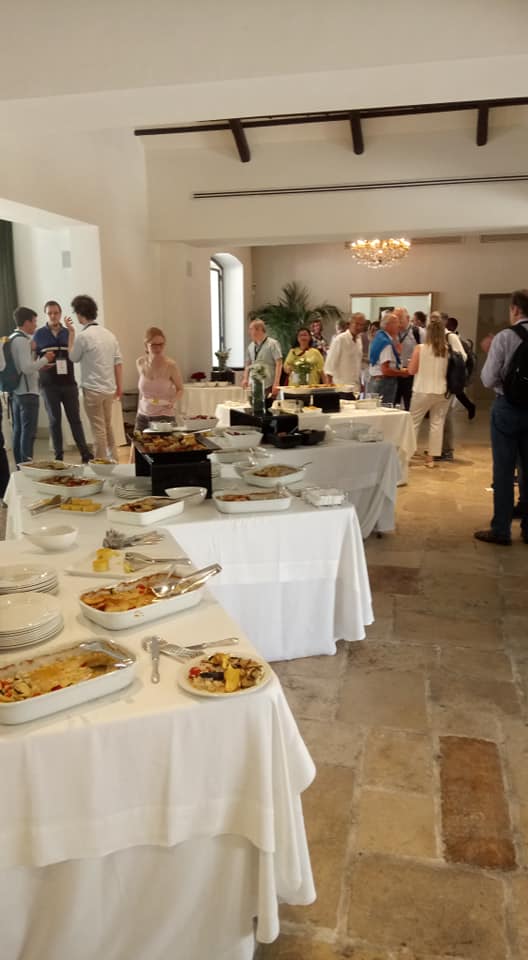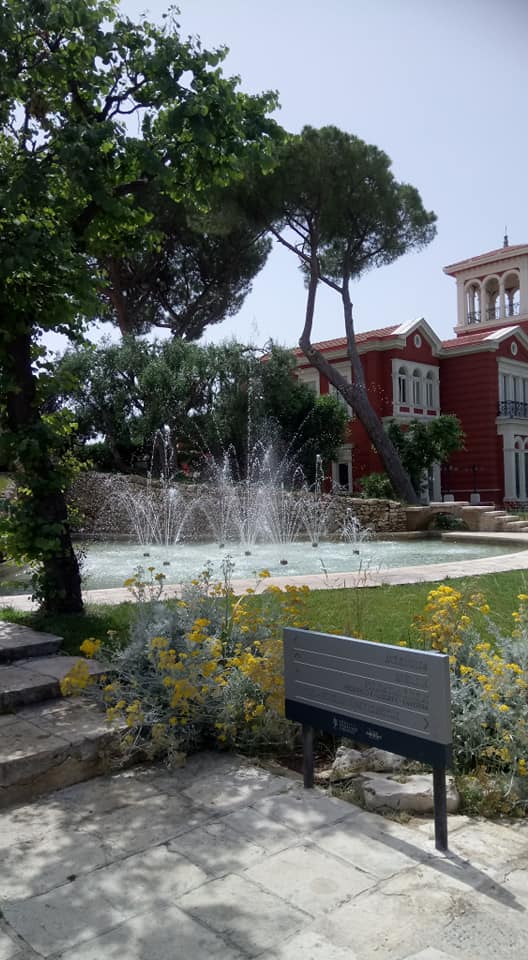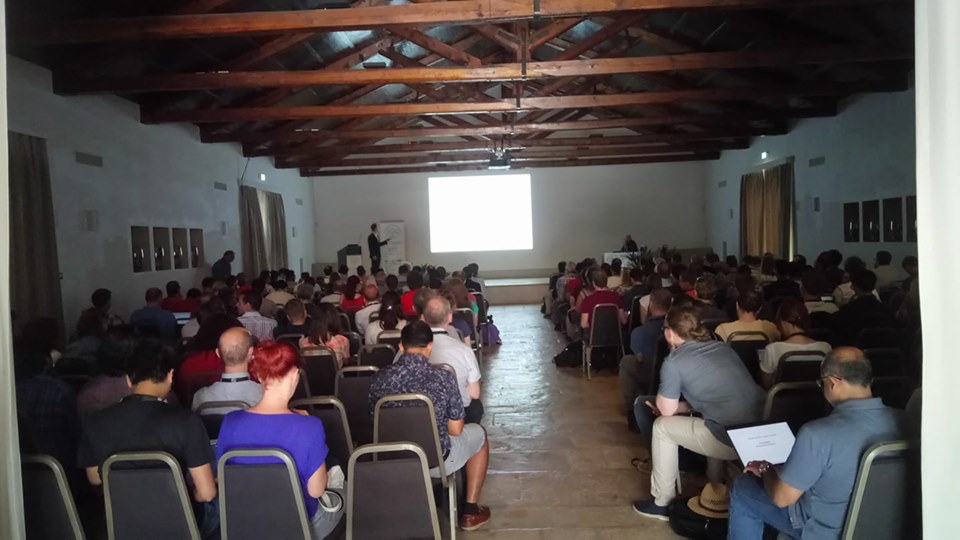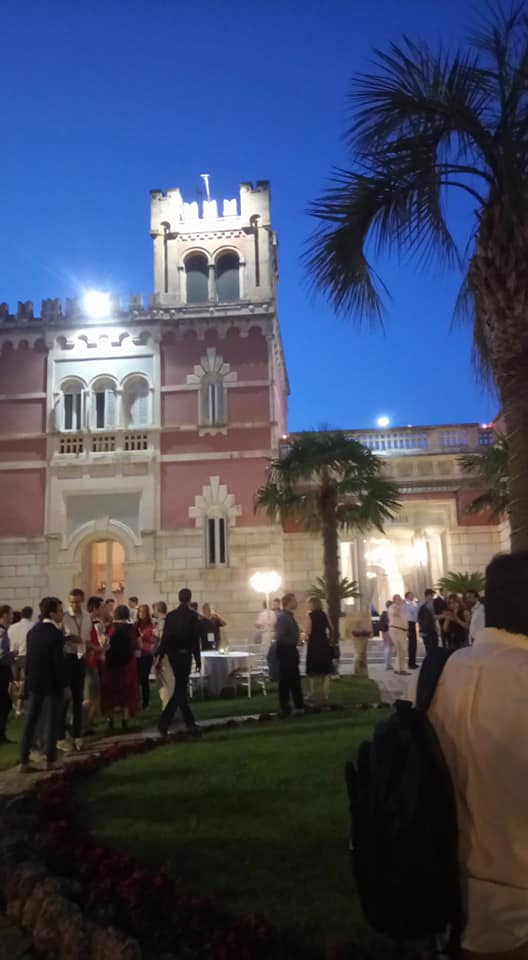#SQM Strangeness in Quark Matter 2019, Bari, Italy

Well, this was Quarks - I'd never been here before in the context of a conference. Neutrinos, yes. Astrophysics and cosmology, yes.
Quarks? No, even though that's where I started, quarks being my first point of contact with the quantum world in 1998. But conference-wise, this was new territory. Was I up for it? Yes. Was I up to it? I don't know, even now.
Life is not as I knew it among the Quarks studied by scientists. I thought they came in triplicate, neatly spinning from one flavour to the next held in sedate coupling by Gluons, carriers of the Strong Force designed to knit Quarks together. Gluons are 'virtual particles', so no-one could be quite sure, ever, where they were or whether they were there or not, just wisps of energy-binding ... well, energy... that let the Quarks move between their states as they wished. Gluons barely got a look-in here except under the title 'QGP' (quark-gluon plasma) because everyone is colliding atomic nuclei to smash out the Quarks, using heavy ions from metals such as gold, lead, and sometimes copper. The resulting collision produces a fireball, a sheared-off ellipse of quark matter that is pondered over in its various guises, and there are plenty of those with three families to choose from and four quarks in each if you count the antimatter versions, which of course you must. Quarks wear coats of many colours, yet this shearing-off process can produce data to let the observers know what their constituent really is.
Beauty and Charm quarks took centre stage at SQM, being the heaviest of the quark family aside from Truth, or Top, which isn't seen very often and didn't get very much PowerPoint play. Heaven sent it was, nevertheless, to see the Beauty quark given its rightful name (except when referring to Bottomonium.). Beauty has a long life, for a Quark. Charm, too, hangs around for a while (and is known to produce Charmonium) before decaying into other things like Pions or Kaons, or even Hyperons. This means they can be more easily analysed, studied, and data-tracked. Strange quarks, strangely enough, stayed mainly in the wings, shouting something about strangeness from time to time but barely seen in any graphic detail. The 'strangeness' label sticks to a particle's life-line - quoting from the link given, "certain particles, such as the kaons or the hyperons (Σ and Λ), were created easily in particle collisions, yet decayed much more slowly than expected for their large masses and large production cross sections. Noting that collisions seemed to always produce pairs of these particles, it was postulated that a new conserved quantity, dubbed "strangeness", was preserved during their creation, but not conserved in their decay.
The symbols given in the quote above, I noticed, contain Lambda (Λ), a particle I grew intimately attached to at Nottingham University. The Σ is for Sigma, and as you'll find if you cross to the link, of Sigma particles there are six (just as there are six quarks), split into Sigma and Sigma Resonance, which given the amount of reference to Resonance that's been occurring in certain quarters lately, has to be topical somewhere... watch this space.
Quarks? No, even though that's where I started, quarks being my first point of contact with the quantum world in 1998. But conference-wise, this was new territory. Was I up for it? Yes. Was I up to it? I don't know, even now.
Life is not as I knew it among the Quarks studied by scientists. I thought they came in triplicate, neatly spinning from one flavour to the next held in sedate coupling by Gluons, carriers of the Strong Force designed to knit Quarks together. Gluons are 'virtual particles', so no-one could be quite sure, ever, where they were or whether they were there or not, just wisps of energy-binding ... well, energy... that let the Quarks move between their states as they wished. Gluons barely got a look-in here except under the title 'QGP' (quark-gluon plasma) because everyone is colliding atomic nuclei to smash out the Quarks, using heavy ions from metals such as gold, lead, and sometimes copper. The resulting collision produces a fireball, a sheared-off ellipse of quark matter that is pondered over in its various guises, and there are plenty of those with three families to choose from and four quarks in each if you count the antimatter versions, which of course you must. Quarks wear coats of many colours, yet this shearing-off process can produce data to let the observers know what their constituent really is.
Beauty and Charm quarks took centre stage at SQM, being the heaviest of the quark family aside from Truth, or Top, which isn't seen very often and didn't get very much PowerPoint play. Heaven sent it was, nevertheless, to see the Beauty quark given its rightful name (except when referring to Bottomonium.). Beauty has a long life, for a Quark. Charm, too, hangs around for a while (and is known to produce Charmonium) before decaying into other things like Pions or Kaons, or even Hyperons. This means they can be more easily analysed, studied, and data-tracked. Strange quarks, strangely enough, stayed mainly in the wings, shouting something about strangeness from time to time but barely seen in any graphic detail. The 'strangeness' label sticks to a particle's life-line - quoting from the link given, "certain particles, such as the kaons or the hyperons (Σ and Λ), were created easily in particle collisions, yet decayed much more slowly than expected for their large masses and large production cross sections. Noting that collisions seemed to always produce pairs of these particles, it was postulated that a new conserved quantity, dubbed "strangeness", was preserved during their creation, but not conserved in their decay.
The symbols given in the quote above, I noticed, contain Lambda (Λ), a particle I grew intimately attached to at Nottingham University. The Σ is for Sigma, and as you'll find if you cross to the link, of Sigma particles there are six (just as there are six quarks), split into Sigma and Sigma Resonance, which given the amount of reference to Resonance that's been occurring in certain quarters lately, has to be topical somewhere... watch this space.
Aldo Mori, Director of Bari University, was quoted on one of the early slides as saying, "Finding the ways of things that touch everybody's lives is the way forward for science," and so it is, I thought on seeing that in the first day of four I'd be attending. Hadron scattering, I learned, behaves like light waves and casts a shadow as an x-ray does. In the same talk I heard first-hand about the nucleons on impact producing fireballs. Primordial time resolution shows an elliptic 'flow' of the final momentum space, which makes the ball of quarks look like this:
Apparently, quantum mechanical diffraction plays a part here, as 'cross-sections in Deuterium' reveal, so it was said; as with much of the conference material, this one was a challenge for my head. But QCD is quantum chromo-dynamics, the study of colour in Quarkdom, where 'colour' is a metaphor for a strangeness not peculiar to strange quarks but characteristic of the whole family - up and down, strange and charm, beauty and truth. So there is a strong relationship between quarks and quantum mechanics, albeit an elusive one when it comes to evidence from data - bear in mind we're still stuck on the candidates for Dark Matter and are unsure where gravity ends or begins. (Add gravity to the Standard Model and you'll always find infinities you have to renormalise.)
"Our research focus," said one presenter, "has evolved from kinky signatures of the QGP equilibrium state," yet not a ripple of laughter pervaded Europa, the grand conference hall stuffed with physicists. These early plenary talks found seats hard to find; despite the capacity audience, 'kinky signatures' met with silence as the speaker went on to explain there are novel tests in the dynamics of hadronisation, but that a perturbation of energy will propagate in space and time.
"Our research focus," said one presenter, "has evolved from kinky signatures of the QGP equilibrium state," yet not a ripple of laughter pervaded Europa, the grand conference hall stuffed with physicists. These early plenary talks found seats hard to find; despite the capacity audience, 'kinky signatures' met with silence as the speaker went on to explain there are novel tests in the dynamics of hadronisation, but that a perturbation of energy will propagate in space and time.
Quantum Field Theory made an appearance - there's "no QFT without non-fluid dynamic excitation." Small systems, the presenter continued, are not only complications, they are tools to enhance and characterise..." but I didn't quite catch what was being enhanced or characterised, only that the complications are probably illusionary (as they generally are in the world we're used to living in), and that in Conformal Kinetic Theory where flow exhibits conformist scaling, there is potential to understand its microscopic dynamics. As above, so below, I thought tritely, feeling comfortable with this strange situation, although strange quarks were notable at this time only by their absence;- :) they'd come along sometime, surely, to their own party. (In the link above, past the Warning that this page is only for physics students, you'll find at the top of the Contents listing 1. Things Bumping Into Other Things which probably gives the game away a little bit.)
Once the plenaries were over for the morning, coffee break brought startlingly good refreshments and two conversations, one with a CERN delegate who explained that quarks and neutrinos share a dynamic in the weak interaction but only quarks partake in the strong interaction (see strong and weak force). Another delegate said there is too much getting bogged down in the data to see the simple truths. With a simple smile, I agreed.
HADES finds that the merging of neutron stars and the collision of gold atoms display a similar identity profile. In coupling to baryons, the data decodes more baryons than anti-baryons, by a long way. And the fireball is structureless, said Manuel Lorenz, presenting, while energy must be produced from the system. "In a simple coalescence approach nuclei are clustered with the help of an afterburner." So something is going on, deep in these realms, where energy is produced from itself in a process I knew I'd have to look up. What was coalescence, anyway?
The quark-model approach to coalescence was markedly more complicated than the one describing water droplets, symptomatic of the territory. I'd found similar over-complications in the neutrino world, just as excusable in being bound by those constraints, but the fireball is not like a neutrino, it's a ball of real, identifiable matter, and even has a magnetic field lasting beyond its visible velocity. Tracking down a neutrino is a very different ballgame - like catching a unicorn on film, you're never sure you've got one bar the tell-tale trail it left behind in the Argon bath. Experiments in Quarkdom are correspondingly lavish in their productions.
Once the plenaries were over for the morning, coffee break brought startlingly good refreshments and two conversations, one with a CERN delegate who explained that quarks and neutrinos share a dynamic in the weak interaction but only quarks partake in the strong interaction (see strong and weak force). Another delegate said there is too much getting bogged down in the data to see the simple truths. With a simple smile, I agreed.
HADES finds that the merging of neutron stars and the collision of gold atoms display a similar identity profile. In coupling to baryons, the data decodes more baryons than anti-baryons, by a long way. And the fireball is structureless, said Manuel Lorenz, presenting, while energy must be produced from the system. "In a simple coalescence approach nuclei are clustered with the help of an afterburner." So something is going on, deep in these realms, where energy is produced from itself in a process I knew I'd have to look up. What was coalescence, anyway?
The quark-model approach to coalescence was markedly more complicated than the one describing water droplets, symptomatic of the territory. I'd found similar over-complications in the neutrino world, just as excusable in being bound by those constraints, but the fireball is not like a neutrino, it's a ball of real, identifiable matter, and even has a magnetic field lasting beyond its visible velocity. Tracking down a neutrino is a very different ballgame - like catching a unicorn on film, you're never sure you've got one bar the tell-tale trail it left behind in the Argon bath. Experiments in Quarkdom are correspondingly lavish in their productions.

ALICE was the belle of the ball, really, appearing everywhere across the PowerPoint plethora. A Large Ion Collider Experiment fell over itself for that acronym, residing at CERN and being allowed to call her cards as they turn. An introduction to her Charm and Beauty production asked if charm hadronisation depends on the collisions, and "essentially it seems that beauty and charm production tells tales on compatibility and unity," at which my ears pricked, for are we missing something, I thought, on the combined front? Compatibility and unity - qualities we strive for, even if they are hard to find.
Then there's the CMS, another heavy-flavour experiment looking for Truth quarks, though you'll find Top quarks referenced everywhere here as Truth is still too hard to swallow. Between heavy quarks and the medium, you'll find from this link that the bonding mechanism is somewhat ubiquitous, but undefined, as if Beauty and Truth broke free from the constraints of the Standard Model on their own terms, which they weren't talking about. However they were certainly talking about something in line with retrocausality because well, quite frankly, they couldn't not, what with all that time-dependent symmetry et al. But then there was another break in which to consume delicious food, and we'd found our way into Day Two somehow in my notebook, filled with frantic scribblings penned while the particular slide of interest was still on the screen, which wasn't for long.
The food, talking flavours if not Italian, was totally amazing. The long-suffering saviours of everybody's appetites slaved away in sculleries and outdoor ovens to provide lavish spreads three times a day, unless Afternoon-Tea phase was interrupted by an excursion (Wednesday) or a banquet elsewhere (Thursday). Exquisite platters of everything healthy and delicious you could possibly find in production from talented chefs were served beautifully on tables where delegates could mill and graze, a million miles from the lunch queues I'd experienced in conferences before. Simon, the maitre, looked after the proceedings flawlessly and was also very kind to me, sending fresh lemonade and pastries when I had to rest an injured foot after an ill-fated excursion over difficult cobbles. I'd already walked miles across Puglia - Materna finished me off with minor damage. The sudden appearance of a waiter placing refreshments by my side was incredibly welcome and never to be forgotten!
Then there's the CMS, another heavy-flavour experiment looking for Truth quarks, though you'll find Top quarks referenced everywhere here as Truth is still too hard to swallow. Between heavy quarks and the medium, you'll find from this link that the bonding mechanism is somewhat ubiquitous, but undefined, as if Beauty and Truth broke free from the constraints of the Standard Model on their own terms, which they weren't talking about. However they were certainly talking about something in line with retrocausality because well, quite frankly, they couldn't not, what with all that time-dependent symmetry et al. But then there was another break in which to consume delicious food, and we'd found our way into Day Two somehow in my notebook, filled with frantic scribblings penned while the particular slide of interest was still on the screen, which wasn't for long.
The food, talking flavours if not Italian, was totally amazing. The long-suffering saviours of everybody's appetites slaved away in sculleries and outdoor ovens to provide lavish spreads three times a day, unless Afternoon-Tea phase was interrupted by an excursion (Wednesday) or a banquet elsewhere (Thursday). Exquisite platters of everything healthy and delicious you could possibly find in production from talented chefs were served beautifully on tables where delegates could mill and graze, a million miles from the lunch queues I'd experienced in conferences before. Simon, the maitre, looked after the proceedings flawlessly and was also very kind to me, sending fresh lemonade and pastries when I had to rest an injured foot after an ill-fated excursion over difficult cobbles. I'd already walked miles across Puglia - Materna finished me off with minor damage. The sudden appearance of a waiter placing refreshments by my side was incredibly welcome and never to be forgotten!
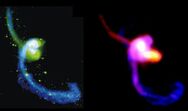
So the show rolled on and it was difficult not to like everything about it, tbh. There was even a presentation about diversity on Wednesday, in which I declared my status as "not being a physicist" to be met with a ripple of laughter soundly rivalling the kinky signatures, and found some support (if not from the presenter herself) for a thought that physics could prove to be the bedrock for social breakthroughs in unity, working as it does in close collaboration with the Universe. My notebook, which is quite sizable, was already half-full rather than half empty.
Discovering in dispatches over lunch that quark and neutrino people don't mix their flavours very much, I felt they were probably missing out, for what's not to compare notes on when you've two families of particles that both oscillate, one relating to the weak force and the other to the strong? On Thursday I ventured a question from the floor, something I'd resisted during this conference for fear of upsetting anyone as I'd managed to do (all too easily) at Invisibles. The presenter had mentioned 'weakly interacting' in reference to a quark on his slide. As the versions of quark matter were so many and varied, I asked, and some of them at least were weakly interacting (as neutrinos weakly interact), could there not in the future be some collaboration found between the quark and neutrino? He was non-committal in his answer, but didn't dismiss the possibility. After my question one of the Masters of this particular ceremony (who happens to be a dead ringer for Anthony Zerbe, so I called him Aizee) stood up to point out,
"To the non-scientist among us, weakly interacting is not weakly interacting."
Oh, I thought. How could that be? Is this humour? "I didn't mean every week," I fired back, "I meant weakly interacting."
Aizee (real name Horst Stoecker) was nevertheless kind enough to send the presenter to my table at lunchtime and explain that in fact weakly interacting in relation to a quark meant not as strongly interacting with the strong force as did other quarks, which wasn't interacting with weak interactions at all. At least, I guessed Aizee had sent him, although I might have been wrong. He might have appeared to interact of his own accord. People do that sometimes. However, given that a prior conversation with a CERN delegate (mentioned earlier) confirmed that weak interaction did indeed take place between quarks, I guess this is another anomaly in paradox that will come to its own light in the fullness of time.
Discovering in dispatches over lunch that quark and neutrino people don't mix their flavours very much, I felt they were probably missing out, for what's not to compare notes on when you've two families of particles that both oscillate, one relating to the weak force and the other to the strong? On Thursday I ventured a question from the floor, something I'd resisted during this conference for fear of upsetting anyone as I'd managed to do (all too easily) at Invisibles. The presenter had mentioned 'weakly interacting' in reference to a quark on his slide. As the versions of quark matter were so many and varied, I asked, and some of them at least were weakly interacting (as neutrinos weakly interact), could there not in the future be some collaboration found between the quark and neutrino? He was non-committal in his answer, but didn't dismiss the possibility. After my question one of the Masters of this particular ceremony (who happens to be a dead ringer for Anthony Zerbe, so I called him Aizee) stood up to point out,
"To the non-scientist among us, weakly interacting is not weakly interacting."
Oh, I thought. How could that be? Is this humour? "I didn't mean every week," I fired back, "I meant weakly interacting."
Aizee (real name Horst Stoecker) was nevertheless kind enough to send the presenter to my table at lunchtime and explain that in fact weakly interacting in relation to a quark meant not as strongly interacting with the strong force as did other quarks, which wasn't interacting with weak interactions at all. At least, I guessed Aizee had sent him, although I might have been wrong. He might have appeared to interact of his own accord. People do that sometimes. However, given that a prior conversation with a CERN delegate (mentioned earlier) confirmed that weak interaction did indeed take place between quarks, I guess this is another anomaly in paradox that will come to its own light in the fullness of time.
CP violation was a hot topic at NNN17 a couple of years ago among the neutrino people - here the violations were limited to Parity but no less referenced in asides, particularly in conversation with Oleg Teryaev, who shared colourful insights en route to the banquet, a lavish affair in a beautiful place, although the food, it must be said, was no match for Simon's servings. Baby octopus didn't hit the fan list for me - seeing them in the tureen was not a pleasant experience. However, it was a banquet, in beautiful gardens, with wonderful company - Vladimir Kekelidze and his friend Alexander Sorin (co-creator of this paper with Oleg) put up with me at their table to share tests, many toasts and not uncommon laughter. Standing up to scientific quick-fire against a high-flight physicist was a thrill in its own right and I'll not be underestimating the resonance. In such salubrious company the evening passed amusingly at light-speed.
I'm going to leave it there, at least in the overview of what was after all a beautiful event, thanking the organisers who brought the party together, so to speak, and really did an outstanding job of doing so. Domenico Elia was said to be the main orchestrator and deserves huge credit for creating this edition of SQM, a gathering that's been happening since 1986 and losing none of its impetus over the years. I hope to catch another one at some future point in spacetime, and to meet again with some of the lovely physicists encountered in Bari. Of the nine international conferences I've been lucky enough to attend so far, this one outperformed on all counts; they could write the book on how to do it, were everyone involved not so busy sorting out the intricacies of quark-gluon exchange.
Nevertheless, the absence of Strangeness at its own celebration was a bit mystifying, and can only really be accounted for by lack of application, which means most probably lack of elucidation as to what Strangeness actually is. Perhaps in the fullness of time, this will change.
I'm going to leave it there, at least in the overview of what was after all a beautiful event, thanking the organisers who brought the party together, so to speak, and really did an outstanding job of doing so. Domenico Elia was said to be the main orchestrator and deserves huge credit for creating this edition of SQM, a gathering that's been happening since 1986 and losing none of its impetus over the years. I hope to catch another one at some future point in spacetime, and to meet again with some of the lovely physicists encountered in Bari. Of the nine international conferences I've been lucky enough to attend so far, this one outperformed on all counts; they could write the book on how to do it, were everyone involved not so busy sorting out the intricacies of quark-gluon exchange.
Nevertheless, the absence of Strangeness at its own celebration was a bit mystifying, and can only really be accounted for by lack of application, which means most probably lack of elucidation as to what Strangeness actually is. Perhaps in the fullness of time, this will change.
Bye bye Bari and your beautiful truths, filled with memorable collisions forging strangely charmed delights.
